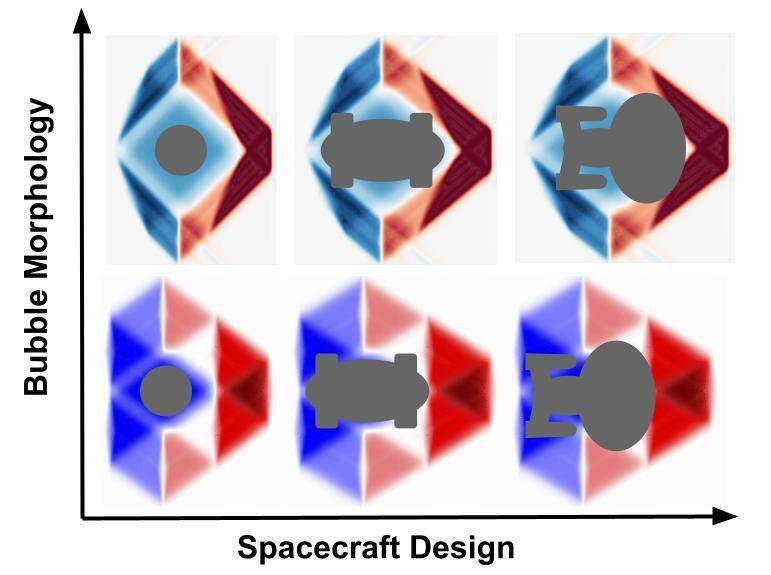
Artistic impression of different spacecraft designs taking into account theoretical shapes of different types of ‘warp bubbles’. Credit: E Lentz
If a journey to distant stars will be possible within the life of an individual, a way of propulsion must be found faster than light. To date, even recent research on superluminal (faster than light) transport based on Einstein’s theory of general relativity would require large amounts of hypothetical particles and states of matter that have ‘exotic’ physical properties, such as negative energy density. This type of material can not currently be found, or can not be manufactured in viable quantities. In contrast, new research done at the University of Göttingen circumvents this problem by constructing a new class of hyperfast ‘solitons’ using sources with only positive energies that can move at any velocity. This raises the debate again about the possibility of traveling faster than light, based on conventional physics. The research is published in the journal Classical and quantum gravity.
The author of the article, dr. Erik Lentz, analyzed existing research and discovered gaps in previous ‘warp drive’ studies. Lentz notes that there are still investigative configurations of space-time curvature organized into ‘solitons’, which have the potential to solve the puzzle while being physically viable. A soliton – in this context also informally called “warp bubble” – is a compact wave that retains its shape and moves at a constant velocity. Lentz derived the Einstein equations for unexplored soliton configurations (where the shift vector components of space-time metrics have a hyperbolic relationship) and found that the altered space-time geometries could be formed in a way that even works with conventional energy sources. In essence, the new method uses the structure of space and time arranged in a soliton to provide a solution for faster-than-light travel, which – unlike other research – requires only sources of positive energy density. No exotic negative energy densities required.
If sufficient energy could be generated, the equations used in this research would allow space travel to Proxima Centauri, our nearest star, and in years instead of decades or millennia back to Earth. This means that an individual can travel there and back within his lifetime. By comparison, current rocket technology would take more than 50,000 years for a one-way trip. In addition, the solitons (chain bubbles) are set to contain an area with minimal tidal forces so that the time course inside the soliton corresponds to the time outside: an ideal environment for a spacecraft. This means that the complications of the so-called ‘twin paradox’ would not be, whereby one twin moving near the speed of light would age much more slowly than the other twins that remained on earth: according to recent comparisons, both twins are the same age would be if reunited.

Image to show how long different types of spacecraft will take to travel from our solar system to Proxima Centauri (the nearest known star). Currently, the only option is to use a chemical rocket that means a travel time of more than 50,000 years. Credit: E Lentz
“This work has moved the problem of faster than light travel a step away from theoretical research in fundamental physics and closer to engineering. The next step is to find out how the astronomical amount of energy needed to get within the scope of contemporary technologies “Then we can talk about building the first prototypes,” says Lentz.
Currently, the amount of energy required for this new type of propulsion for space is still enormous. Lentz explains: “The energy required for this ride, which travels at a speed of light that includes a spacecraft 100 meters in radius, is about hundreds of times the mass of the planet Jupiter. The energy savings will have to be drastic, about 30 orders of magnitude. He added: “Fortunately, previous research has suggested several energy-saving mechanisms that could potentially reduce the energy needed by almost 60 orders of magnitude.” Lentz is currently in the early stages of fixing state whether these methods can be adapted, or that new mechanisms are needed to reduce the energy required to what is currently possible.
A potential model for an actual physical warp
Erik W Lentz, Break the warp: hyper-fast solitons in Einstein-Maxwell plasma theory, Classical and quantum gravity (2021). DOI: 10.1088 / 1361-6382 / abe692
Provided by the University of Göttingen
Quotation: Break the barrier for faster than light travel (2021, March 9) Retrieved March 9, 2021 from https://phys.org/news/2021-03-warp-barrier-faster-than-light.html
This document is subject to copyright. Except for any fair trade for the purpose of private study or research, no portion may be reproduced without the written permission. The content is provided for informational purposes only.
